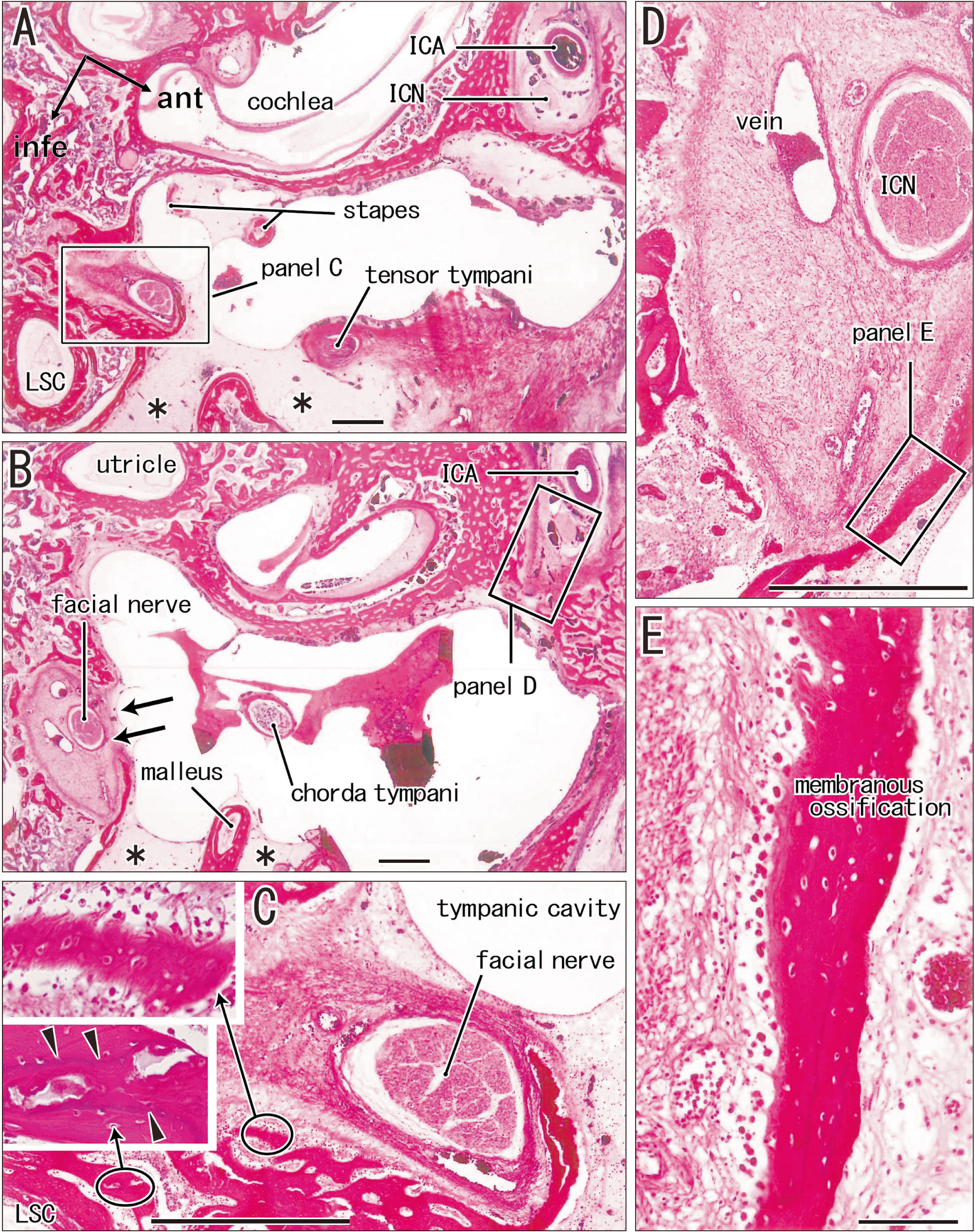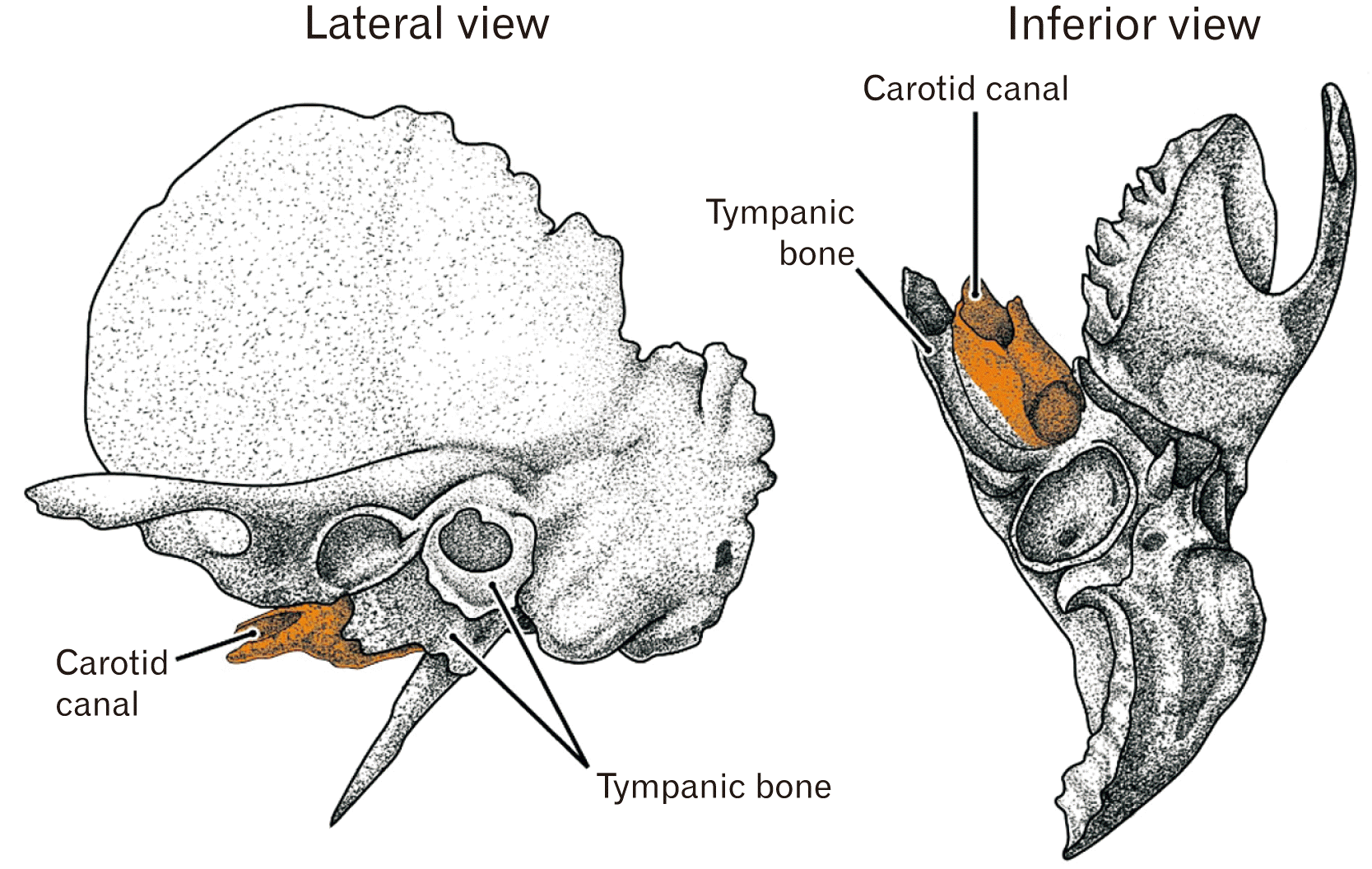Introduction
Materials and Methods
Results
Observations of the midterm fetuses
 | Fig. 2Initial carotid canal in sagittal sections: a wide gap or loose space between the cochlear wall and the sphenoid. Azan staining (A–D) or H&E staining (E, F). (A, B) A fetus of crown-rump length (CRL) 97 mm (approximately 13 weeks); (C, D) CRL 100 mm (13 weeks); (E, F) CRL 105 mm (14 weeks). (B) and (D) are higher magnification view of the center of (A) and (C), respectively. (F) is a higher magnification view of a square in (E). The left-hand side of each panel corresponds to the anterior side of the head. The ala temporalis of the sphenoid (ala) is ossified in (B) and (D), while it is cartilaginous in (E). In (D), an inferior part of the ala (ala with asterisk) looks like a pterygoid. In contrast, most parts of the pterygoid of the sphenoid is bony (B, E). (F) Shows the pterygoid containing two modes of the ossification. (B, D, E) Stars indicate a linear mesenchymal condensation corresponding to the future antero-inferior margin of the petrosal part of the temporal bone. Scale bars: (A, C) 5 mm; (B, D, E) 1 mm; (F) 0.1 mm. ABD, abducant nerve; AP, alar process; DPN, deep petrosal nerve; ICA, internal carotid artery; IR, inferior rectus of the eye; PPG, pterygopalatine ganglion; PTT, pharyngotympanic tube; tent, tentorium cerebelli; TG, trigeminal ganglion. |
 | Fig. 3Initial carotid canal in horizontal sections: a slit surrounded by the cochlear wall, alar process (AP) and basisphenoid. Azan staining. (A–C) A fetus of crown-rump length (CRL) 49 mm (approximately 10 weeks); (D) CRL 52 mm (10 weeks); (E) CRL 95 mm (13 weeks); (F) CRL 100 mm (14 weeks). The upper side of each panel corresponds to the anterior side of the head. The basisphenoid, a large cartilage mass, contains both the notochord (NC) and hypophysial fossa (fossa). The internal carotid artery is surrounded by the petrosa or cochlear wall posteriorly, the AP anteriorly and the basisphenoid medially. A slit between the petrosa and sphenoid appears to be narrower in larger specimens. All scale bars: 1 mm. chiasma, optic chiasma; HP, hypophysis; ICA, internal carotid artery; ON, optic nerve; SPS, superior petrosal sinus; TG, trigeminal ganglion. |
Observations of the late-stage fetuses
 | Fig. 4Wide and dense mesenchymal tissue containing the internal carotid artery and extending between the cochlear wall and sphenoid. Horizontal sections. A fetus of crown-rump length (CRL) 228 mm (approximately 28 weeks). H&E staining. (A) or (D) displays the most superior (or inferior) site in the figure. (E–G) are higher magnification views of squares in (A), (B), and (D), respectively. The left-hand side of each panel corresponds to the anterior side of the head. In these superior sections, no structure delineates the future carotid canal except for the bony alar process (AP) of the sphenoid. Instead, a dense mesenchymal tissue extends between the cochlear wall and sphenoid and it contains abundant veins. (A–D) or (E–G) were prepared at the same magnification; (A, E) Scale bar: 1 mm. ala, ala temporalis of the sphenoid; GPN, greater petrosal nerve; ICA, internal carotid artery; ICN, internal carotid nerve; MXN, maxillary nerve (intracranial course); TG, trigeminal ganglion. |
 | Fig. 5Initial ossification of the carotid canal starts in the dense mesenchymal tissue connecting to the anterosuperior end of the cochlear wall. Sagittal sections. A fetus of crown-rump length (CRL) 276 mm (approximately 32 weeks). H&E staining. Panel (A) containing the future cavernous sinus, displays the most medial site in the figure. (C) and (E) are higher magnification views of squares in (B) and (D), respectively. Panel (F) corresponding to a square in (E), exhibits the membranous ossification starts in the in the dense mesenchymal tissue connecting to the anterior end of the cochlear wall. The left-hand side of each panel corresponds to the anterior side of the head. Note an inferior margin (stars in A–E) of the dense mesenchymal tissue extends between the cochlear wall and the sphenoid (the alar process [AP], ala temporalis [ala] and pterygoid): it connects with the pharyngotympanic tube cartilage in (B) and (D). The palatine bone (PB) looks like a part of the pterygoid (A). Scale bars: (A–E) 1 mm; (F) 0.1 mm. ala, ala temporalis of the sphenoid; ABN, abducant nerve; ICA, internal carotid artery; IR, inferior rectus of the eye; MXN, maxillary nerve in the round foramen; OCN, oculomotor nerve; PPG, pterygopalatine ganglion; PTT, pharyngotympanic tube; SPS, superior petrosal sinus; TG, trigeminal ganglion. |
 | Fig. 6Carotid canal is involved into the bony cochlear wall. Sagittal sections. A fetus of crown-rump length (CRL) 274 mm (approximately 31 weeks). H&E staining. The left-hand side of each panel corresponds to the superior side of the head. Panel (A) containing the future cavernous sinus, displays the most medial site in the figure. (B) or (C) is a higher magnification view of a square in (A) or (B). The inferior side of each panel corresponds to the anterior side of the head (long arrow in A). In the medial part of the carotid canal (A–C), a membranous ossification is on-going. In contrast, in the lateral part, a bony process of the cochlear wall (arrow in D, E) appears to surround the carotid canal from the inferior side rather than from the superior side (Fig. 3D). Stars in (D) indicate an inferior margin of the dense mesenchymal tissue (corresponding to that in Fig. 3A, B) extends between the cochlear wall and sphenoid (ala temporalis or ala). Asterisk in (F) indicates the medial end of the growing tympanic cavity. Scale bars: (A, B, D–F) 1 mm; (C) 0.1 mm. AP, alar process of the sphenoid; ICA, internal carotid artery; ICN, internal carotid nerve; MHT, meningohypophysial trunk of the internal carotid artery; OPN, ophthalmic nerve; PTT, pharyngotympanic tube; SPS, superior petrosal sinus; TG, trigeminal ganglion. |
 | Fig. 7Carotid and facial nerve canals adjacent to the tympanic cavity: membranous ossification in these septa. Sagittal sections. A fetus of crown-rump length (CRL) 272 mm (approximately 31 weeks). H&E staining. The left-hand side of each panel corresponds to the posterior side of the head. Panel (A) displays a plane 1.2 mm medial to (B). (A, B) Contain the carotid and facial nerve canals: the septum is developing for the internal carotid artery (ICA), while the latter canal still opens widely to the tympanic cavity (arrows in B). (C) or (E) is a higher magnification view of a square in panel (A) or (D). The left-hand side of each panel corresponds to the anterior side of the head. Near the facial nerve, membranous ossification (upper insert of C) coexist endochondral ossification indicated by a tidemark (arrowheads; lower insert). (D) A section near (B), exhibits a site corresponding to a square in (B). (E) A higher magnification view of a square in (D), shows membranous ossification in a septum between the carotid canal and tympanic cavity. Scale bars: (A–D) 1 mm; (E) 0.1 mm. Magnification of inserts, same as (E). ant, anterior; infe, inferior; ICN, internal carotid nerve; LSC, lateral semicircular canal. |




 PDF
PDF Citation
Citation Print
Print




 XML Download
XML Download